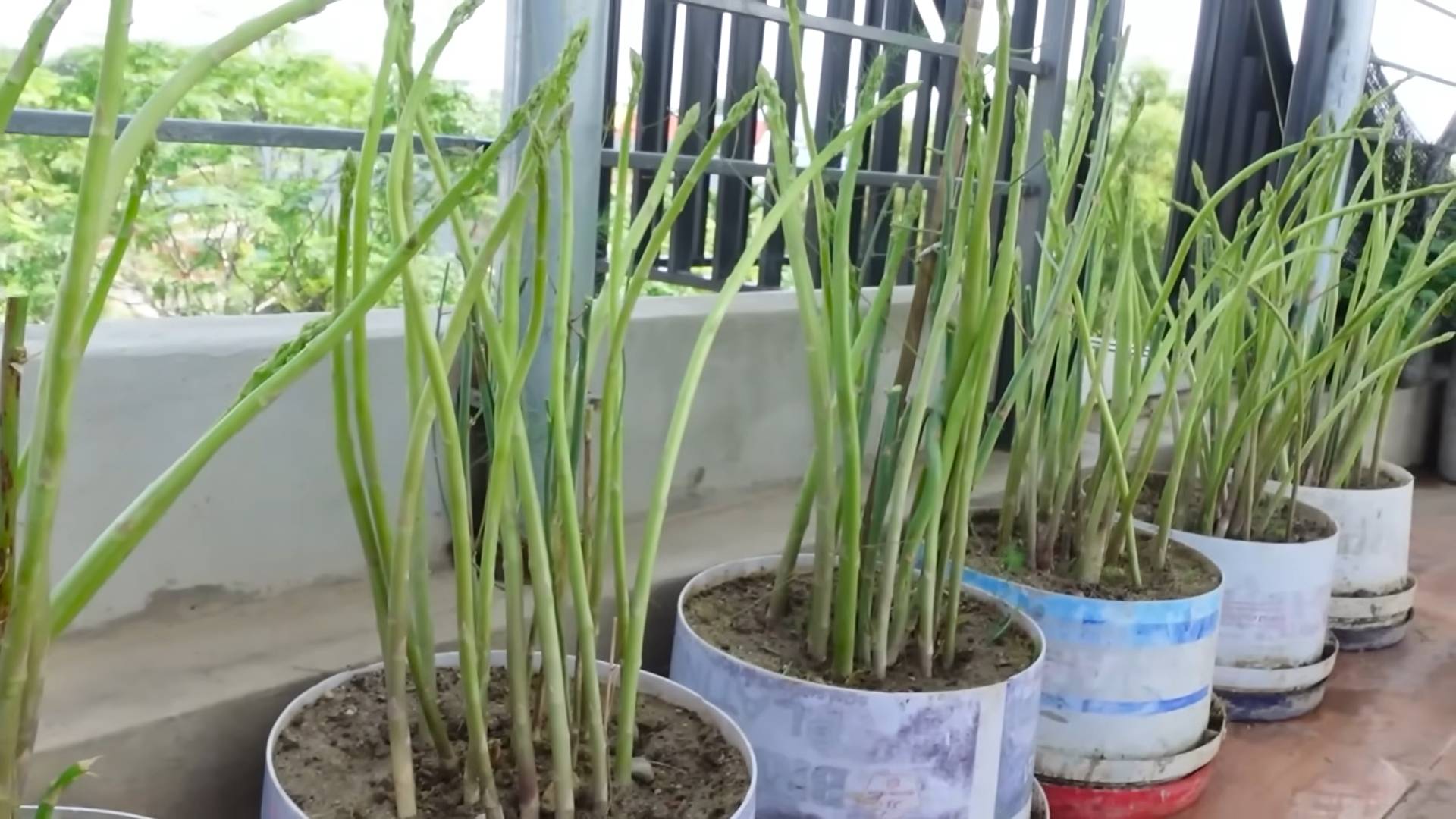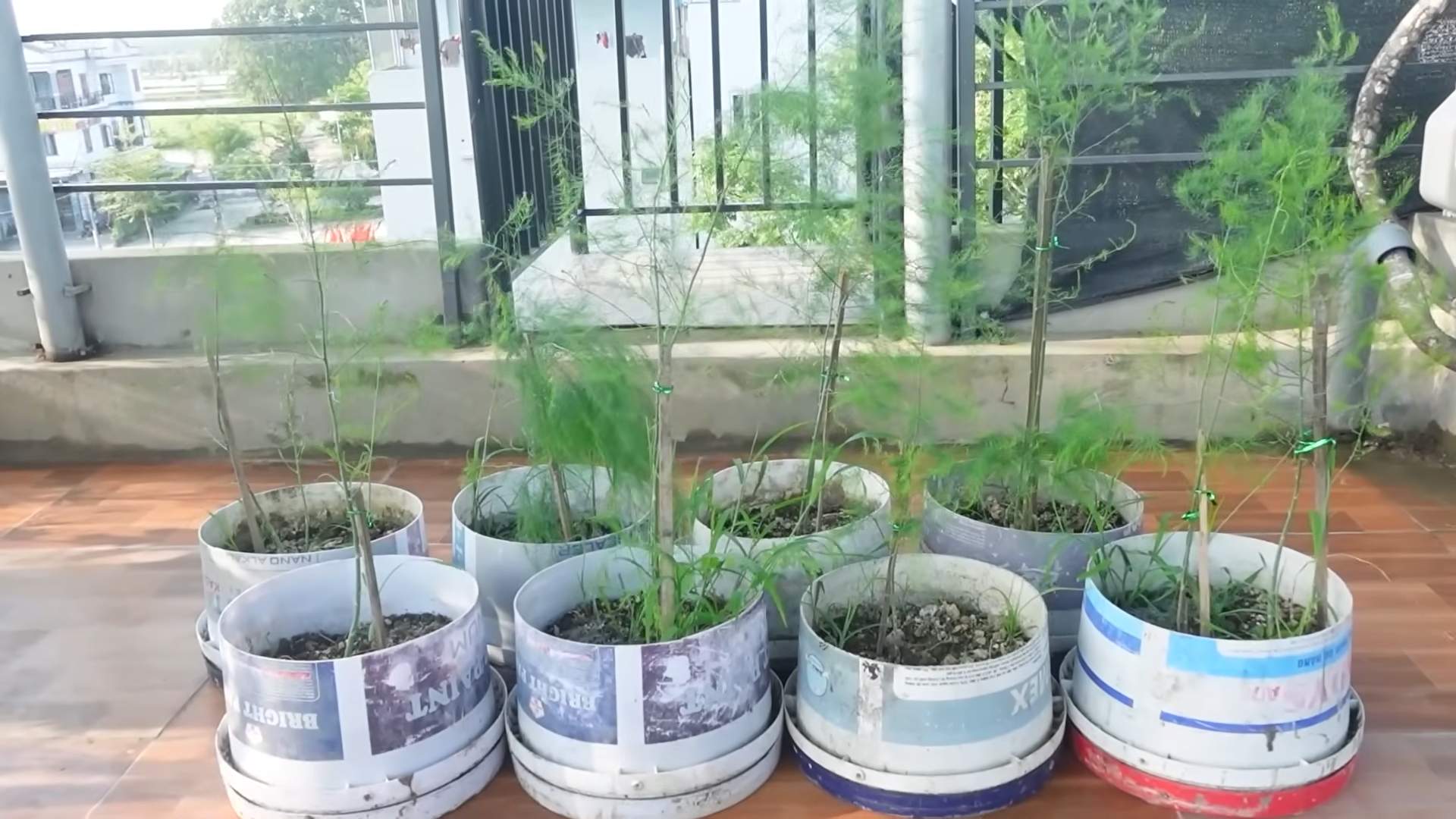Growing Asparagus at Home might seem like a challenge reserved for seasoned gardeners, but I’m here to tell you it’s totally achievable, even if you’re just starting out! Imagine stepping into your backyard and harvesting your own tender, delicious asparagus spears 鈥?fresher than anything you’ll find at the grocery store. That’s the dream, right?
Asparagus has a rich history, dating back to ancient Greece and Rome, where it was prized for its medicinal properties and culinary delights. The Romans even had special asparagus farms! Today, while we might not be building elaborate farms, we can certainly bring a piece of that history to our own homes.
Why should you try growing asparagus at home? Well, for starters, homegrown asparagus tastes incredible! Plus, it’s a perennial plant, meaning you plant it once and enjoy harvests for up to 20 years. Think of it as a long-term investment in deliciousness. But beyond the taste, knowing exactly where your food comes from and nurturing it yourself is incredibly rewarding. This DIY guide will break down the process into easy-to-follow steps, so you can confidently cultivate your own asparagus patch and enjoy fresh, flavorful spears for years to come. Let’s get started!

Growing Asparagus at Home: A Beginner’s Guide
Asparagus, that delectable spring vegetable, is surprisingly easy to grow at home, even if you don’t have a sprawling garden. It’s a perennial, meaning you plant it once and enjoy harvests for up to 20 years! I’m going to walk you through everything you need to know to get started, from choosing the right variety to harvesting your first spears.
Choosing Your Asparagus Variety
Before you even think about digging, you need to decide what kind of asparagus you want to grow. There are male and female varieties, and all-male varieties are generally preferred because they produce more spears and don’t self-seed, which can lead to overcrowding. Here are a few popular choices:
* Jersey Knight: This is a widely recommended all-male variety known for its high yields and disease resistance. It’s a great choice for beginners.
* Jersey Giant: Another all-male variety, Jersey Giant produces large, thick spears. It’s also disease-resistant and a reliable producer.
* Purple Passion: If you want something a little different, Purple Passion offers beautiful purple spears that turn green when cooked. It’s sweeter and more tender than green varieties.
* Mary Washington: This is an older, heirloom variety that’s still popular for its flavor and hardiness. It’s a good choice if you’re looking for something traditional.
Preparing Your Asparagus Bed
Asparagus needs a well-drained, sunny location. It prefers a slightly acidic soil (pH 6.5-7.0). I can’t stress enough how important soil preparation is for asparagus. It’s a long-term investment, so you want to get it right from the start.
* Sunlight: Asparagus needs at least 6-8 hours of direct sunlight per day.
* Soil Drainage: Asparagus roots don’t like to sit in water, so well-drained soil is crucial. If your soil is heavy clay, you’ll need to amend it with plenty of organic matter.
* Soil pH: Test your soil pH and amend it if necessary to bring it into the 6.5-7.0 range. You can use lime to raise the pH or sulfur to lower it.
* Weed Control: Asparagus doesn’t compete well with weeds, so it’s important to eliminate them before planting.
Planting Asparagus Crowns
Asparagus is typically grown from crowns, which are one-year-old plants. You can purchase crowns from a nursery or online. I recommend buying certified disease-free crowns to ensure a healthy start.
1. Timing: The best time to plant asparagus crowns is in early spring, as soon as the soil can be worked.
2. Digging the Trench: Dig a trench that is about 12 inches wide and 6-8 inches deep. If you’re planting multiple rows, space them about 4 feet apart.
3. Amending the Soil: Mix compost or well-rotted manure into the soil you removed from the trench. This will provide nutrients and improve drainage.
4. Creating a Ridge: Create a small ridge of soil down the center of the trench. This will support the asparagus crowns.
5. Placing the Crowns: Place the asparagus crowns on the ridge, spacing them about 12-18 inches apart. Make sure the roots are spread out evenly.
6. Covering the Crowns: Gently cover the crowns with about 2 inches of soil. Water thoroughly.
7. Gradual Filling: As the asparagus spears emerge, gradually fill in the trench with soil. This will encourage the crowns to develop a strong root system. By the end of the first growing season, the trench should be completely filled in.
Caring for Your Asparagus Patch
Asparagus requires regular care to thrive. Here’s what you need to do:
* Watering: Water regularly, especially during dry periods. Asparagus needs consistent moisture to produce healthy spears.
* Fertilizing: Fertilize in early spring with a balanced fertilizer. You can also side-dress with compost or well-rotted manure.
* Weed Control: Keep the asparagus patch free of weeds. Hand-pulling is the best option, as herbicides can damage the asparagus.
* Mulching: Mulch around the asparagus plants with straw, wood chips, or other organic material. This will help to retain moisture, suppress weeds, and regulate soil temperature.
* Fern Management: After the harvest season, allow the asparagus ferns to grow and mature. These ferns will nourish the crowns for the following year’s harvest. In late fall or early winter, after the ferns have turned brown, cut them back to the ground.
Harvesting Asparagus
Patience is key when it comes to harvesting asparagus. You shouldn’t harvest any spears during the first year after planting. This allows the crowns to establish a strong root system.
* Second Year: In the second year, you can harvest a few spears, but only for a short period (about 2 weeks).
* Third Year and Beyond: In the third year and beyond, you can harvest asparagus for a longer period (6-8 weeks).
* Harvesting Technique: To harvest asparagus, snap off the spears at ground level. The spears should be about 6-8 inches long.
* Harvesting Frequency: Harvest asparagus every day or every other day during the peak harvest season. This will encourage the plants to produce more spears.
* End of Harvest: Stop harvesting when the spears become thin and spindly. This indicates that the plants need to rest and replenish their energy reserves.
Dealing with Asparagus Pests and Diseases
Asparagus is generally a hardy plant, but it can be susceptible to a few pests and diseases. Here are some common problems and how to deal with them:
* Asparagus Beetles: These beetles can damage the spears and ferns. Hand-picking the beetles and larvae is the best way to control them. You can also use insecticidal soap.
* Asparagus Rust: This fungal disease can cause orange or brown pustules on the ferns. Choose rust-resistant varieties and ensure good air circulation to prevent rust.
* Fusarium Crown and Root Rot: This fungal disease can cause the plants to wilt and die. Plant asparagus in well-drained soil and avoid overwatering to prevent fusarium.
Extending Your Asparagus Season
Want to enjoy asparagus for even longer? Here are a few tips:
* Succession Planting: Plant different varieties of asparagus that mature at different times. This will extend your harvest season.
* Cold Frames: Use cold frames to protect your asparagus plants from frost and extend the growing season in the spring and fall.
* Forcing Asparagus: You can force asparagus indoors during the winter. Dig up some crowns in the fall and replant them in containers. Keep them in a cool, dark place for several weeks, then move them to a warmer, brighter location to encourage them to produce spears.
Enjoying Your Homegrown Asparagus
There’s nothing quite like the taste of freshly harvested asparagus. It’s delicious steamed, roasted, grilled, or added to salads and soups. I love to simply roast it with a little olive oil, salt, and pepper. You can also blanch and freeze asparagus to enjoy it throughout the year.
Growing asparagus at home is a rewarding experience. With a little patience and care, you can enjoy fresh, delicious asparagus for many years to come. I hope this guide has given you the confidence to get started. Happy gardening!

Conclusion
So, there you have it! Growing asparagus at home isn’t just a gardening project; it’s an investment in years of delicious, fresh, and incredibly rewarding harvests. Forget those limp, overpriced spears at the grocery store. Imagine stepping into your backyard and snipping vibrant, tender asparagus whenever the craving strikes. This DIY trick transforms your garden into a source of culinary delight, offering a flavor profile that store-bought asparagus simply can’t match.
Why is this a must-try? Because it’s more than just growing a vegetable; it’s about connecting with your food, understanding its lifecycle, and enjoying the fruits (or rather, the spears!) of your labor. It’s about sustainability, reducing your carbon footprint, and knowing exactly where your food comes from. Plus, let’s be honest, there’s a certain satisfaction in serving a dish featuring asparagus you nurtured from a tiny crown.
But the beauty of growing asparagus at home lies in its adaptability. Feel free to experiment! Try different varieties of asparagus crowns to find your favorite flavor profile. ‘Jersey Knight’ is a popular choice for its high yield and disease resistance, while ‘Purple Passion’ offers a sweeter taste and stunning visual appeal. Consider companion planting to enhance growth and deter pests. Marigolds, for example, are known to repel nematodes, while basil can deter asparagus beetles.
Don’t have a large garden? No problem! While asparagus prefers in-ground planting, you can successfully grow it in raised beds or even large containers. Just ensure adequate drainage and plenty of space for the roots to spread. Remember to amend the soil with plenty of organic matter, regardless of your chosen method.
We encourage you to embrace this DIY trick and embark on your own asparagus-growing adventure. It might seem daunting at first, but with a little patience and care, you’ll be rewarded with a bountiful harvest for years to come. The initial investment of time and effort pays off exponentially in terms of flavor, freshness, and the sheer joy of growing your own food.
And most importantly, we want to hear about your experience! Share your tips, tricks, and triumphs in the comments below. What variety did you choose? What challenges did you face, and how did you overcome them? Your insights can help other aspiring asparagus growers succeed. Let’s build a community of home gardeners, sharing our knowledge and passion for fresh, homegrown food. So, grab your gardening gloves, prepare your soil, and get ready to enjoy the unparalleled taste of homegrown asparagus! Let us know how your **growing asparagus** journey goes!
Frequently Asked Questions (FAQ)
How long does it take to harvest asparagus after planting?
Patience is key when growing asparagus! While it might be tempting to harvest immediately, it’s crucial to allow the plants to establish themselves. Generally, you shouldn’t harvest any spears during the first year after planting crowns. In the second year, you can harvest lightly for a few weeks, but only if the plants are vigorous and healthy. By the third year, you can enjoy a full harvest season, typically lasting 6-8 weeks. This waiting period allows the plants to develop strong root systems, ensuring a bountiful harvest for years to come. Harvesting too early can weaken the plants and reduce future yields.
What kind of soil is best for growing asparagus?
Asparagus thrives in well-drained, sandy loam soil with a pH between 6.5 and 7.5. Good drainage is essential, as asparagus roots are susceptible to rot in soggy conditions. Before planting, amend the soil with plenty of organic matter, such as compost or well-rotted manure. This will improve drainage, fertility, and water retention. If your soil is heavy clay, consider adding sand or perlite to improve drainage. A soil test can help you determine the pH and nutrient levels of your soil, allowing you to make necessary amendments before planting.
How much sun does asparagus need?
Asparagus needs at least 6-8 hours of direct sunlight per day to thrive. Choose a planting location that receives full sun throughout the growing season. Insufficient sunlight can result in weak, spindly spears and reduced yields. If you live in a particularly hot climate, some afternoon shade may be beneficial, but generally, the more sun, the better.
How often should I water asparagus?
Asparagus needs consistent moisture, especially during the growing season. Water deeply and regularly, especially during dry spells. Aim to keep the soil consistently moist but not waterlogged. A good rule of thumb is to water when the top inch of soil feels dry to the touch. Mulching around the plants can help retain moisture and suppress weeds. Avoid overhead watering, as this can promote fungal diseases. Instead, water at the base of the plants.
What are common asparagus pests and diseases?
Asparagus is relatively pest-resistant, but there are a few common issues to watch out for. Asparagus beetles are a common pest that can damage the spears and foliage. Handpicking the beetles or using insecticidal soap can help control infestations. Asparagus rust is a fungal disease that can cause orange pustules on the foliage. Good air circulation and avoiding overhead watering can help prevent rust. Fusarium wilt is another fungal disease that can cause the plants to wilt and die. Planting disease-resistant varieties and ensuring good soil drainage can help prevent Fusarium wilt. Nematodes can also be a problem, attacking the roots and stunting growth. Soil solarization or planting nematode-resistant cover crops can help control nematode populations.
How do I harvest asparagus?
Harvest asparagus spears when they are about 6-8 inches tall and the tips are still tightly closed. Use a sharp knife to cut the spears at ground level. Avoid damaging the crown or surrounding spears. Harvest spears every day or two during the peak of the season. As the harvest season progresses, the spears will become thinner and more fibrous. At this point, it’s time to stop harvesting and allow the plants to fern out.
What do I do with asparagus ferns after the harvest season?
After the harvest season, allow the asparagus plants to fern out. The ferns will photosynthesize and store energy in the roots, which will fuel next year’s growth. In the fall, after the ferns have turned brown, cut them back to a few inches above the ground. This will help prevent diseases and pests from overwintering in the garden. You can also add a layer of compost or well-rotted manure around the plants to provide nutrients for the following season.
Can I grow asparagus in containers?
Yes, you can grow asparagus in containers, but it requires a large container and careful attention to watering and fertilization. Choose a container that is at least 18 inches deep and wide. Use a well-draining potting mix and amend it with plenty of organic matter. Water regularly and fertilize every few weeks with a balanced fertilizer. Container-grown asparagus may not produce as much as in-ground asparagus, but it’s a great option for gardeners with limited space.
What are some good companion plants for asparagus?
Several plants can benefit asparagus when planted nearby. Tomatoes, basil, parsley, and marigolds are all good companion plants for asparagus. Tomatoes help deter asparagus beetles, while basil and marigolds repel nematodes. Parsley attracts beneficial insects that can help control pests. Avoid planting asparagus near onions, garlic, or potatoes, as these plants can inhibit asparagus growth.
How long will my asparagus plants last?
With proper care, asparagus plants can last for 15-20 years or even longer. The key to longevity is to provide them with good soil, adequate sunlight, consistent moisture, and protection from pests and diseases. Regular fertilization and mulching can also help extend the lifespan of your asparagus plants.





Leave a Comment